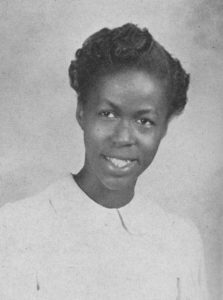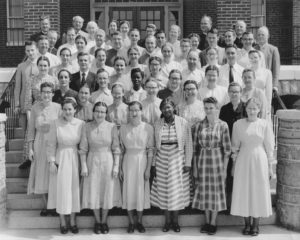“Diversify” is a one of four key goals of EMU’s strategic plan and a committee on diversity and inclusion plays a key role in campus life and decision making. However, the broader culture, country and our small community have much work to do to welcome all. This timeline shows the painful realities of exclusion that is part of the EMU story. We celebrate change, and acknowledge that we fall short.
***
1864 – Virginia Mennonite Conference (VMC) dictates that Mennonites cannot own or trade slaves, and sets restrictions for receiving slave labor.
1917 – Eastern Mennonite School (EMS) is established.
1920 – VMC debates allowing Black people in their churches. They are allowed with caution.
1925 – Two “mulatto” girls are accepted as members of Peake Mennonite Church after a year of deliberation.
1925 – VMC disapproves of marriages and close friendships between races.
1930s – EMS student Thelma McConnell (white) begins visiting the Black neighborhood of Newtown in Harrisonburg.
1935 – The EMS Young People’s Christian Association (YPCA) begins holding cottage prayer meetings in local Black homes, led by Thelma McConnell.
1934 – Ernest Swartzendruber (white) takes two years of classes at EMS (received BS in ’64).
4/1936 – YPCA cottage prayer meetings get funding from VMC to rent a building for mission church services. Students and faculty clean out a vacant storefront at the corner of Gay and Federal Streets, and hold Sunday school in the morning for whites, and afternoon for blacks. Ernest Swartzendruber becomes the superintendent. The community objects to Black and white services being held in the same building. Rowena Lark (Black) helps lead a summer Bible school.
10/1936 – The mission separates into two buildings, black in the original building and white on Chicago Ave. Ernest Swartzendruber remains superintendent of the Black mission.
1938 – The mission board is uneasy reaching out to Black adults instead of just children. They consider closing down the Black mission. Ernest invites EMS professor Ernest E. Gehman to host evangelist meetings. Rowena makes waves by singing expressively, preaching during the children’s service, and being close friends with Ernest’s wife Fannie. In the next few years Rowena leaves for Chicago, where she is better received by white Mennonites.
1940 – Four Black adults ask to be baptized into the mission church. They are baptized in December.
1940 – Thomas Stewart applies to take Bible courses at EMS, and is told he will have to do so by correspondence because of “opposition likely to arise between the attitudes of the northern and southern students,” and because the state had ruled against integrated public schooling.
1941 – VMC and the Mission board put together rules about Black and white integration at church. It is opposed by many mission members, including Ernest and Fannie.
1942 – VMC gives funding for a permanent building, Broad Street Mission.
1943 – Roberta Webb becomes the first Black Harrisonburg resident to become Mennonite (at Broad Street Mission). Notice is given on March 10: “Last Sunday in our communion service one more was added to the number of members here. Pray for this lady, Mrs Webb, that she may re¬main faithful to her promise and bring her daughters to her Saviour.” She begins pressuring EMS to enroll her three daughters.
In a Sept. 13 service at “Gay Street Mennonite Mission for the Colored,” Students Lester Eshleman and George R. Brunk contributed to the main part of the service. The following description also appears: Sister Webb, a recent convert, led the closing song “Steal away to Jesus,” and she knew how to do it.
1943 – Fed up with the mission’s racial attitudes, Fannie Swartzendruber storms out of a segregated communion service, and begins walking the four miles home with daughter. A few months later, she and Ernest are removed from their positions by the Mission Board.
1944 – EMS student Margaret Derstine recounts tension on campus about Black students. One poster circulates, depicting the president blessing a graduate off to be a missionary in Africa, while the dean holds the back door closed to Black applicant.

1945 – Margaret “Peggy” Webb, Roberta’s daughter, applies to EMS. The administration suggests she go to Hesston, which she does.
That same year, the May 2 Weather Vane reports in “Tabulated Tidbits,” that “At the request of the Webb sisters, Ralph Shenk with a girls’ quartet went to the colored school to regive his sermon on ‘Perennial Romance.’ The group enjoyed a dinner at the school cafeteria.”
1945 – Faced with Black applicants, the EMS Board of Trustees writes in their minutes, “we feel that at this time it would be unwise to admit such students into the co-educational institution. However we express our heartfelt sympathies for our colored brethren and sisters with their education problems and are ready to open up such measures of opportunity for them as such opportunities are expedient and possible.”
1945 – TheEMS President’s daughter Grace Mumaw, a sophomore at EMHS, visits the Lucy Simms School for a mixed-audience D.C. gospel choir performance.
1946 – Rowena Lark’s husband James becomes the first Black person ordained in the Mennonite church.
1946 – EMS accepts its first non-white students, a brother and sister from China.
1947 Ada Webb, daughter of Roberta, applies and is denied. She attends night classes at Roosevelt College in Chicago.
1948 – The EMS board of trustees refers the decision on admitting Black students to the VMC. VMC refers back to EMS to make its own decision.
1948 – Willis Johnson (Black) enrolls as a part-time high school Bible student. He, along with the other five Black students first enrolled at EMC do not finish their degrees due to social, financial and academic obstacles.

1949 – Ada Webb (Roberta’s daughter) is accepted at EMC’s junior college as the first full-time Black student. According to a letter from classmate Abram Hostetter to Jay B. Landis, she had to sit in back of chapel alone, while everyone else was arranged by alphabet. Nobody would walk with her, so Hostetter started accompanying her across campus.
She transfers to Hesston College, and later graduates from La Junta School of Nursing (La Junta, Co.) in 1955.
1950 – Marjorie Thompson is the first Black student to stay in the EMC dorm. She leaves after one semester.

1952 – Peggy Webb Howard is admitted to EMC after being personally invited back by President John R. Mumaw.
1952 – President Mumaw is visited by a Black friend from an African mission; a restaurant downtown refuses to serve them together in the main dining room.
1953 – White student Jay B. Landis wins an oratorical contest with an essay advocating for racial equality.
April 1954 – Peggy Webb Howard is the first Black student to graduate from EMC. She and Jay B. Landis co-wrote and led their commencement song. She did not wear a head covering to the ceremony. Howard earned a BS in music, social science, and secondary education, and was a member of the Zelathean and Mennonite Historical clubs.
May 1954 – The Supreme Court case Brown v. Board of Education rules segregation in schools unconstitutional.

1954 – EMC sociology student Aubrey Shenk goes to Zion Mennonite Church in Broadway to record reactions to EMC’s desegregation policies. She receives varied responses. One EMC grad there, a young businessman, is all for integration. The pastor discourages them, and mentions that the “Yankee” teachers at EMHS were his first introduction to the Gettysburg address.
1955 – VMC lifts strictures on integrated worship.
1957 – In the Jan-Feb issue of Broad Street Mennonite Church’s Missionary Light, Paul Peachey commends BSMC for “its stand in desegregation ahead of the times.”
1958 – Virginia public schools integrate.

1959 –The Richmond Times Dispatch runs a story on six Virginia colleges accepting Black students, and notes that EMC was the first.
1960 – Vincent Harding and wife Rosemarie Freeney (the first Black Goshen College graduate) accept positions with Mennonite Central Committee to open the integrated Peace House in Atlanta.
1962 – Vincent and Rosemarie Harding first visit campus, and challenge Mennonites to advocate for racial equality. They feel that Harrisonburg Mennonites are unaware of and insensitive towards inequality. They find out a Mennonite hotel owner turned away the Black parents of an EMC student.
1962 –EMC’s radio program The Mennonite Hour pushes a racial equality agenda, and gets community pushback.
1962 –EMC and EMHS play basketball games against the Black students of Lucy Simms High School.
1962 – D.C. native Grandison Hill begins classes at EMC (one of four Black students that year) in August. He encounters both a sense of community and racism, and transfers out after one year.
1963 – The Hardings visit Harrisonburg again, and go to EMC and Broad Street Church. Professors John Lapp and Samuel Horst, inspired by their visit, form the committee largely responsible for the desegregation of Harrisonburg schools and hotels.

1963 – The Hardings meet with EMC graduate Titus Bender (white) in Missisippi, where he shocks the couple by publicly embracing them.
Martin Luther King, Jr. gives the “I Have A Dream” speech in August on the National Mall.
1966 – Student Lee Roy Berry becomes the first Black student on stage: the May 13 Weathervane reported that he “captured the psychological struggle of Othello” in his performance put on by the Promethian Literary Society. [He went on to be a celebrated bilingual attorney in Goshen, Indiana, and a professor of political science at Goshen College.]1971 – The YPCA continues outreach to the African American community in Newtown.
1980-85 – Abraham Davis becomes the first director of the Cross-Cultural Center, precursor to Multicultural and International Student Services.
1986 – Eric Payne MA ’16 first enrolls at EMU, and feels isolated and alienated. He helps form the precursor to the Black Student Union (BSU). Payne leaves EMU in 1987.

1997 – Peggy Webb Howard Christopher visits EMU to speak in classes and at a Coming Together service in the Discipleship Center.
1997 – Melody Pannell (who would later become Director of Multicultural Services and a professor) graduates as one of 70 American students of color from EMU.
2005 – Melody Pannell organizes a BSU reunion; 25 alumni attend.
2006 – The graduating class includes 148 American students of color.
2011 – Professor Mark Sawin leads a chapel about desegregation; Jay Landis and other classmates of Peggy Webb Howard Christopher attend.
2014 – Vincent Harding visits campus to give the Albert Keim History Lecture “Is America Possible?,” and presents in undergraduate and seminary chapels.
2016 – The Black Student Union organizes a Town Hall on Race, with other activities during Black History Month.
2016 – EMU hosts the national gathering of Coming to the Table.
2016 – A faculty/staff conference meets on “Embracing Diversity.”
2017 – BSU hosts a second Town Hall on Race, with more diverse participation.
2017 –The Donning of the Kente ceremony, in its second year, honors accomplishments of students of color.
